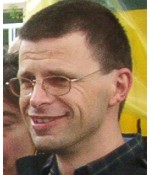| "Oxygen-modulated gene expression"
|
|||||
| Informationen für Studierende | |||||
| Project 1 | Project 2 | Project 3 | Project 4 | ||
Prof. Dr. Thomas Kietzmann |

|
Thomas Kietzmann
EMail: kietzmann@chemie.uni-kl.de Phone: *49-631-205-4953 Fax: *49-631-205-3419
|
Members of the group
Phone: *49-631-205-3032
Fax: *49-631-205-3419 Working in related projects:
|
| Program |
Adaptation to changes in the ambient O2 tension is essentially required for the adequate energy supply of humans and all other aerobic living organisms. The process of extracting O2 from the environment and its distribution not only for oxidative phosphorylation but also as a substrate for other biochemical reactions has been conserved through evolution. The heterogeneous O2 distribution in tissues requires adaptation of the cellular functions to optimize organ functions. Cells located at the arterial inflow have other metabolic properties and thus differ in their enzymatic equipment from cells located at the venous end. To meet the needs for such different functions an O2 sensing system has to control the long-term adaptation via regulation of gene expression. Within this system sensors and regulatory transcription factor(s), several chemical modifications such as phosphorylation, hydroxylation and oxidation reactions appear to be involved. Our investigations are conducted (i) on the role of physiological oxygen gradients between the periportal and the perivenous zone of the liver acinus with respect to the differential activation of the phosphoenolpyruvate carboxykinase gene and the glucokinase gene (ii) on the hemostasis-, diabetes- and tumor-associated gene expression with special espect to plasminogen activator inhibitor-1 expression (iii) the role of oxygen and nutrient regulated transcription factors and their possible cross-talk (iv) and the role of oxidative stress and inflammatory mediators on the regulation of the heme oxygenase-1 gene. |
| Experimental Models |
Isolated and cultured hepatocytes from the liver of rat, mouse and man; hepatoma cell lines; hormone-producing pancreatic and other tumor cell lines; adult, regenerating and cirrhotic rat liver; subcellular membrane fractions; transgenic and gene-deleted (knock out) mice. |
| Experimental Methods |
Cloning of genes; DNA sequencing; modification of DNA by insertion, deletion and site specific mutagenesis; promoter analysis by footprints and transfection of reporter gene constructs as well as DNA protein interactions using electrophoretic mobility shift assay (EMSA), Southwestern blots; determination of gene activity by nuclear-run-on, RT-PCR, differential display RT-PCR, Northern and Western blots, in situ hybridizations, immunobiochemical protein determinations; protein purification by various chromatographic and electrophoretic procedures; generation and purification of polyclonal and monoclonal antibodies; preparation of subcellular fractions such as endoplasmic reticulum or mitochondria; generation of transgenic and gene-deleted (knock out) mice. |
| Research Projects | |
| Project 1 | Modulation of gene activation by oxygen: Zonation of the hormone-dependent activation of the phosphoenolpyruvate carboxykinase-1 and the glucokinase gene in liver parenchyma |
| Project 2 | Hemostasis-, diabetes- and tumor-associated gene expression: Regulation of the plasminogen activator inhibitor-1 gene |
| Project 3 | Hypoxia-, hormone- and nutrient-dependent transcription factors |
| Project 4 | Heme oxygenase-1, inflammation and oxidative stress: Gene regulation of heme oxygenase-1 in liver |